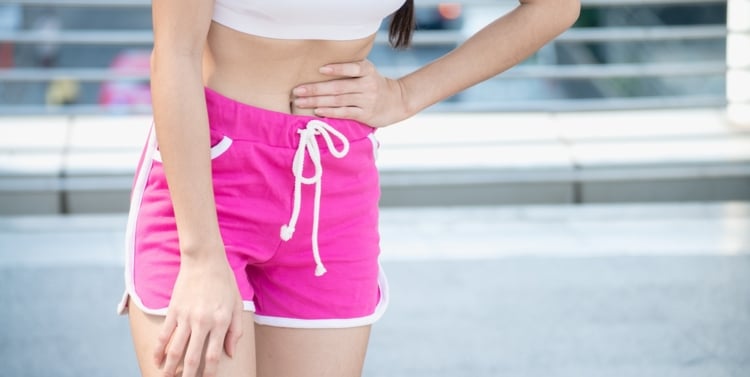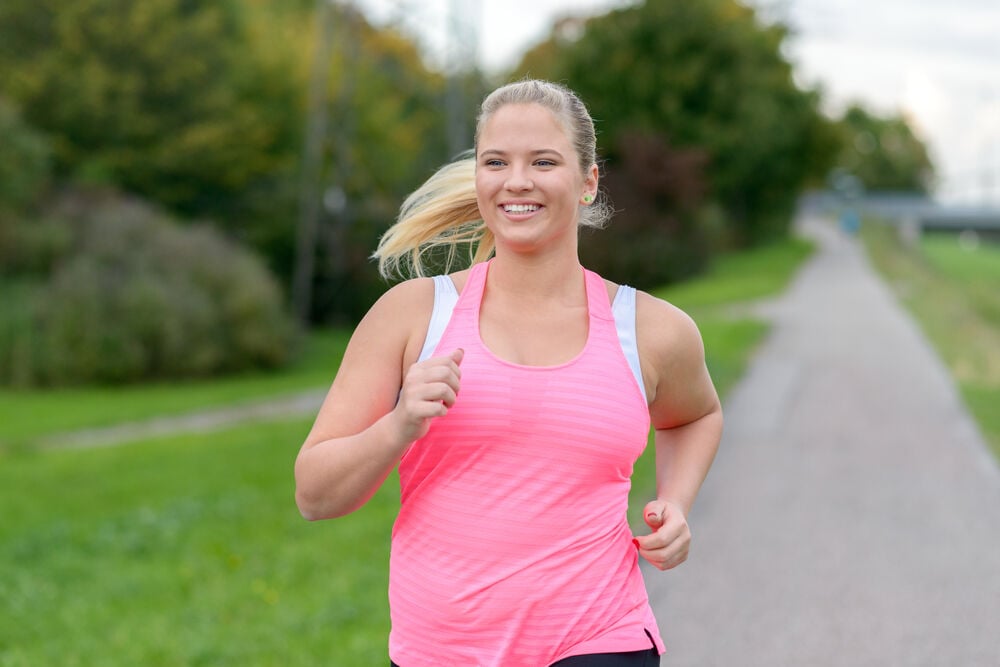Learn how running during your period can alleviate PMS discomfort and even boost your mood.
-
Tracking cycle
-
Getting pregnant
-
Pregnancy
-
Help Center
-
Flo for Partners
-
Anonymous Mode
-
Flo app reviews
-
Flo Premium New
-
Secret Chats New
-
Symptom Checker New
-
Your cycle
-
Health 360°
-
Getting pregnant
-
Pregnancy
-
Being a mom
-
LGBTQ+
-
Quizzes
-
Ovulation calculator
-
hCG calculator
-
Pregnancy test calculator
-
Menstrual cycle calculator
-
Period calculator
-
Implantation calculator
-
Pregnancy weeks to months calculator
-
Pregnancy due date calculator
-
IVF and FET due date calculator
-
Due date calculator by ultrasound
-
Medical Affairs
-
Science & Research
-
Pass It On Project New
-
Privacy Portal
-
Press Center
-
Flo Accuracy
-
Careers
-
Contact Us
Running during your period actually has some great benefits. Here’s why


Every piece of content at Flo Health adheres to the highest editorial standards for language, style, and medical accuracy. To learn what we do to deliver the best health and lifestyle insights to you, check out our content review principles.
Does the thought of running during your period make you want to chuck your jogging shoes in the closet? If you’re concerned about how periods may affect your running routine, you’re in good company. For many reasons, people may feel like skipping exercise during their periods. Thankfully, you can still do activities such as running safely while menstruating. Exercising or performing many other kinds of physical activity, including running during your period, can actually help reduce discomfort and boost your mood.
The fitness world is full of misconceptions. Here you can read about the 10 most popular fitness myths.
Sticking with a running routine can alleviate some of the symptoms that accompany menstruation. For example, running on your period may elevate your mood by releasing endorphins, as well as relieve cramps and back pain associated with periods.
How the menstrual cycle affects your running
Although every person’s body is unique, the average menstrual cycle lasts about 28 days. In this case, ovulation will occur on approximately day 14 of the menstrual cycle. The first half of the menstrual cycle is known as the follicular phase, while the second half of the cycle is called the luteal phase.
The follicular phase starts with the onset of each period and lasts for approximately 14 days (ranging from 10 to 16 days). After your period, which can last for two to seven days, estrogen levels rise and peak around day 14, just before ovulation. Then, a surge in luteinizing hormone occurs, prompting ovulation. The levels of another hormone called progesterone remain low for this phase.
During the luteal phase, which usually lasts for around 14 days, progesterone levels rise. After ovulation, estrogen levels drop. If no fertilization of the egg occurs, the levels of both progesterone and estrogen drop abruptly. The luteal phase ends with the start of menstruation, and the cycle begins again.
If you experience heavy bleeding during menses, then the hemoglobin concentration of your blood may decrease. Since hemoglobin is the part of red blood cells that transports oxygen, this drop in hemoglobin can temporarily affect your blood’s oxygen-carrying ability.
Some menstruating runners may develop a condition called false anemia or sports anemia, in which the iron levels of the blood become low after physical activity. Athletes tend to have lower hemoglobin concentrations than people leading a more sedentary lifestyle. As a result, this false anemia is an adaptation to aerobic exercise like running.
Your body temperature changes throughout the menstrual cycle. It peaks during the luteal phase of the cycle in response to the increase in progesterone. This means your body’s cooling functions don’t switch on as quickly. Your body’s temperature is lower during the follicular phase due to higher estrogen levels.
Running during either the follicular or the luteal phase can be done safely. If you choose to exercise outside during the luteal phase, your temperature may remain elevated, especially in hot weather. This is important to keep in mind, as you will not start sweating to cool down until your body has reached a higher temperature. However, maintaining a consistent exercise routine can enhance your body’s ability to regulate temperature over time.
Fluctuations in hormone levels can impact your running performance. Estrogen may enhance endurance by altering the metabolism of proteins, fats, and carbohydrates, and progesterone may oppose these effects of estrogen. Eating plenty of high-fiber carbohydrates can also help fuel your runs, especially in the follicular phase of your cycle.

Take a quiz
Find out what you can do with our Health Assistant
Benefits of running during your period
Everyone feels different in various phases of the menstrual cycle. That’s why the duration and intensity of each training should be determined individually, depending on how you feel at the moment.
If you’re experiencing a heavy menstrual flow or cramps, you may want to schedule your run for another day.
However, if you feel ready — go for it! Make sure to stay hydrated and stretch after activity to reduce any soreness.
The mental and physical benefits of running don’t stop because you are menstruating. In fact, running during your period may actually relieve some symptoms of PMS through the following steps:
- Releasing natural endorphins: running during your period may release natural endorphins, which boost your mood and act as a natural painkiller.
- Minimizing discomfort: running during your period may also increase blood circulation, which promotes oxygen flow and can minimize bloating or swelling.

Tips for running during your period
Let’s go over some key tips for running during your period:
Stay hydrated
Staying hydrated is always important while running. If you are running during your period, fluid replacement is especially important.
As a general estimate, drink four to six ounces of fluid every 20 minutes during your runs.
Pace yourself
If you choose to go running during your period, make sure to rest well. Get plenty of sleep and take at least one rest day per week so that your body can recharge before you run again.
Stretch beforehand
Perform dynamic stretches before your run, as they can warm you up for cardio training. As a bonus, stretching can also help relieve period cramps.
Find a partner
Invite a friend, a colleague, or a relative to join you while running during your period. Exercising with other people is not only fun but can also keep you accountable for staying active.
Stick to a healthy diet
Eating a healthy diet will help you feel your best when running during your period. Include lots of fresh, whole foods such as fruits, grains, and vegetables. Also, eating a healthy diet and limiting your intake of salt may reduce bloating and abdominal discomfort during periods.
Prep your hygiene items
Plan your period hygiene for before, during, and after the run in advance. Choosing the right products can help you feel more comfortable when running during your period.
Breathe
While running during your period, breathe naturally. Don’t breathe only through the nose as this may restrict your breathing and may limit the quantity of oxygen you inhale. Breathing through both your mouth and nose will provide unrestricted oxygen.
Key takeaways
Depending on their cycles and life circumstances, many people may think about skipping their exercise routine during their periods. But exercising, particularly running, during your period offers many benefits. In fact, running during your period may release natural endorphins, improving your mood and reducing pain or discomfort.
To keep your runs safe and rewarding, take steps to stay hydrated, get plenty of rest, and stretch before and after each run. Exercising with a friend is a great way to build consistency. If you do run during your period, planning your period hygiene and breathing naturally through both your mouth and nose can make the activity more enjoyable. After your run, make sure to refuel with fresh, whole foods and plenty of fluids.


Hey, I'm Anique
I started using Flo app to track my period and ovulation because we wanted to have a baby.


The Flo app helped me learn about my body and spot ovulation signs during our conception journey.


I vividly
remember the day
that we switched
Flo into
Pregnancy Mode — it was
such a special
moment.
Real stories, real results
Learn how the Flo app became an amazing cheerleader for us on our conception journey.




